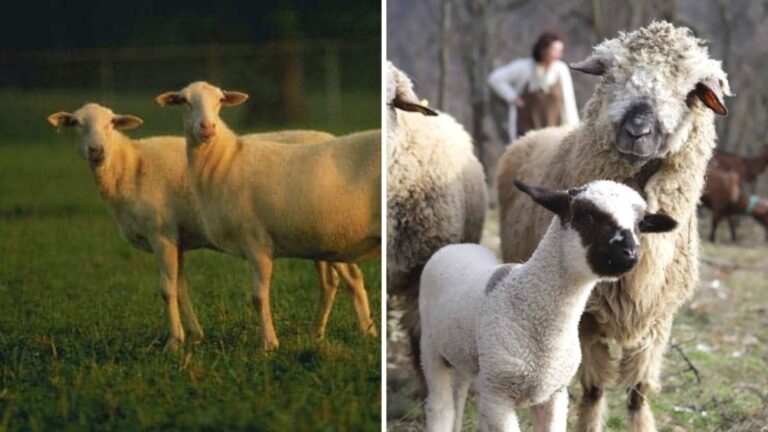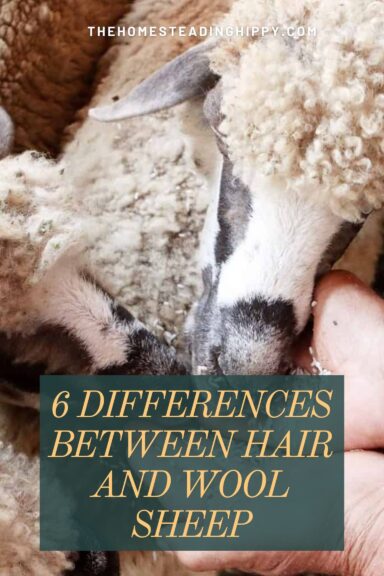Sheep have been domesticated for a very long time, and as with every domesticated species of animal, humanity has developed many different breeds. Each of these breeds is optimized for a specific purpose, a specific environment, or just for greater productivity, but when it comes to sheep in particular there is one major difference between domestic breeds: whether or not they have hair or wool.

Both sheep have a coat, yes, but the unique characteristics inherent to hair and wool breeds go much deeper than what you see on the outside of their bodies.
| Trait | Hair Sheep Breeds | Wool Sheep Breeds |
| Coat Type | Short, coarse hair | Dense wool fleece |
| Shedding | Shed hair naturally, no shearing required | Require shearing regularly |
| Parasite Resistance | Generally more resistant to parasites | Prone to parasite infestations |
| Temperament | More energetic and curious | More docile |
| Reproduction Rate | Typically have high fertility rates | Fertility rates may vary |
| Resistance to Temperature Extremes | Well-adapted to both hot and cold temperatures | Better insulation, suited for colder climates |
| Purpose for Being Raised | Mainly raised for their meat | Valued for dairy and wool production |
It’s no exaggeration to say that choosing a hair or wool breed is fundamentally important for your flock depending on your goals and where you live.
To help you make this choice, I’m going to share with you six important differences between the two types of sheep that you need to know. We’ll get right into it below…
The Quantity of the Two Fiber Types
I want to let you in on a little secret. Both types of sheep, wool breeds and hair breeds, each have a type of fiber. It’s true!
Wool sheep have hair, and hair sheep have wool, but the difference is in the quantity of each type of fiber that they have. Hair sheep have predominantly hair and very little or next to no wool, while wool sheep will have only a little bit of hair.
And truly, the abundance of one type of fiber over the other is what places any given breed in one category or another. More than that, it’s also a stark illustration that reveals how adapted a given breed is to its environment.
This is more of an academic difference than a practical one, but I will cover all of the practical considerations on the rest of the list.
Their Resistance to Extreme Weather
One of the most fundamental differences between wool and hair sheep is their inherent resistance to temperature extremes. In short, hair sheep are better adapted to hot, humid environments whereas wool breeds do much better in the cold.
Most hair breeds are descended or at least developed from sheep that originally hail from equatorial, tropical, or subtropical regions whereas wool breeds come from or likewise developed from stock originally found in far northern or far southern latitudes.
And this makes perfect sense: wool is incredibly insulating and not just when we turn it into garments; it protects the sheep that grow it in exactly the same way, and this is why breeds like the Merino do fine in cold weather.
Likewise, the very last thing you would want to wear in the desert or in the tropics is a wool sweater, and you prefer something that is lighter, airy, and more breathable. Sheep that live there, like the St Croix or Barbados Blackbelly, likewise have sort and breathable hair for the same reason.
This doesn’t mean that there’s no opportunity for overlap in terms of ideal environment, and some temperate regions will allow sheep of either type to do just fine.
That being said, you’re always wise to assess your typical climate conditions throughout the year and choose breeds accordingly.
Why They Are Raised
A good rule of thumb concerning the differences between our two types of breeds is that wool sheep are more often raised for wool, whereas hair breeds are more often raised for meat.
Both breeds also have adequate milk producers, and there are some breeds that are used as dual-purpose sheep for wool and milk, milk and meat, or wool and meat but this distinction is generally dependable.
To be clear, it’s technically possible to harvest the hair from hair breeds, but it’s not an industry unto itself as it is with wool and the breeds that produce it.
On a similar note, you can get meat from any sheep, but today only the breeds from either category that are bred for meat production produce mutton and lamb that is of notable quality.
And when it comes to milk quality and output, most wool breeds have a distinct edge.
Grooming Requirements
Probably the single biggest practical difference, and to some would-be shepherds the game-changer, is the grooming requirements between the two types of domestic sheep.
The bottom line is that hair breeds don’t require shearing. Their hair either grows out and falls out slowly over time, being continually replaced or they maintain a relatively short coat that requires very little in the way of upkeep or maintenance.
These sheep take care of themselves when it comes to grooming outside of keeping them clean and checking them over for injuries or infections.
Wool sheep are the polar opposite. Wool sheep breeds, with precious few exceptions, require shearing.
This isn’t just to harvest the fleeces which can be turned into useful textiles, but it’s also a necessity for their overall health and well-being: cheap the dark sheared of their wool will become wool down, overloaded, weighed down and filthy, and they might not even be able to see!
Whatever reasons you are keeping wool sheep, even if it’s just for meat and milk, you’re still going to have to share them periodically for their comfort and health. This can be a big job sometimes, and it can be a massive job if you have a large flock so take that into account.
Size
Most hair breeds tend to be smaller than wool breeds. This means that they don’t need quite as much space, inside or out, but it also means that carcass yields are lower, something to keep in mind if you’re harvesting them for their meat.
On the other hand, hair breeds will accordingly need less food overall, and less food to gain an equivalent amount of weight. This might be a net efficiency improvement depending on your goals.
Each breed is somewhat variable, of course, and there are large breeds belonging to both categories, as well as medium and small breeds. But all things being equal, our hot-weather hair breeds tend to be smaller animals overall.
Temperament
And what is bound to be the most contentious difference between these two similar, yet different, domestic categories of sheep: temperament.
I know they’re going to be some people protesting this one but I’m sticking to my guns: In my experience, and I’ve got plenty with both wool and hair sheep, hair sheep tend to be a little harder to manage, a little more standoffish and a little meaner.
This can be a minor issue for a seasoned shepherd, or a really big deal for a neophyte that is dealing with an unrepentant and seriously pissed-off ram.
And yes, before you bring it up, sheep breeds can surprise you when it comes to the “known” baselines for temperament…
I’ve seen wool flocks that are known for docility and have turned out downright monstrous, and likewise, hair breeds known for aggression that were basically puppy dogs. But what you can’t forget is that sheep are true flock animals, and the attitudes of all are mostly determined by the rest of the flock.
With hair breeds, I have found that this means they are always a little “quicker on the trigger” when it comes to flighty behavior, aggression, and surliness.

Tim is a farm boy with vast experience on homesteads, and with survival and prepping. He lives a self-reliant lifestyle along with his aging mother in a quiet and very conservative little town in Ohio. He teaches folks about security, prepping and self-sufficiency not just through his witty writing, but also in person.
Find out more about Tim and the rest of the crew here.
